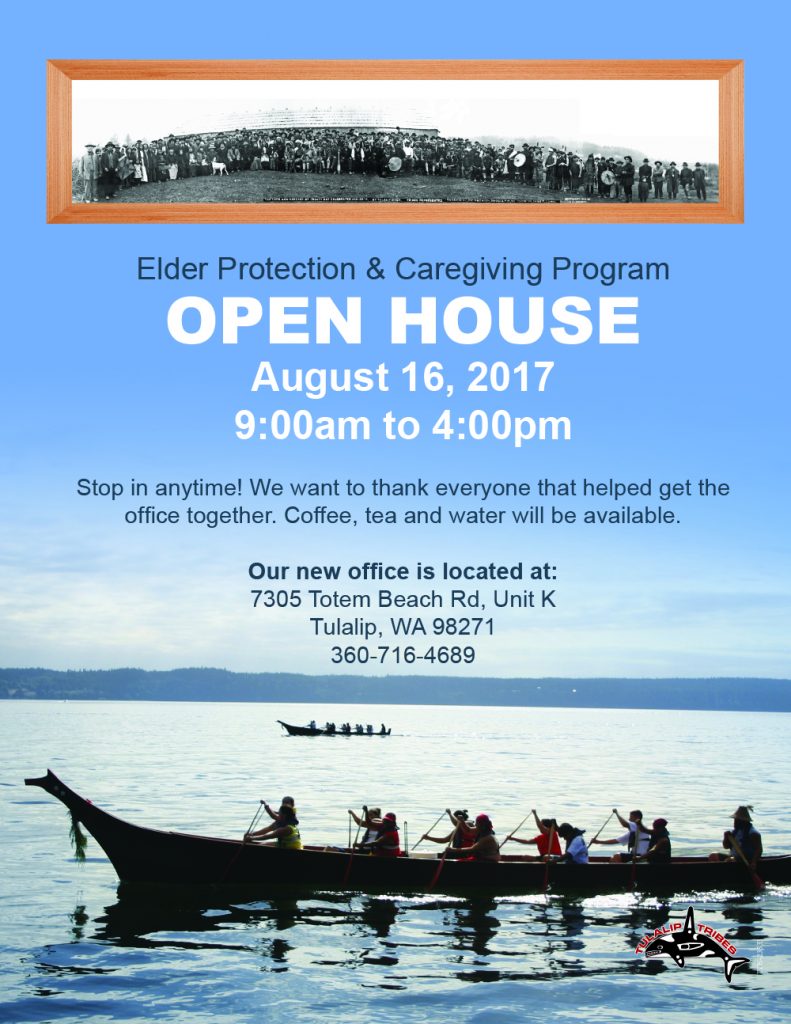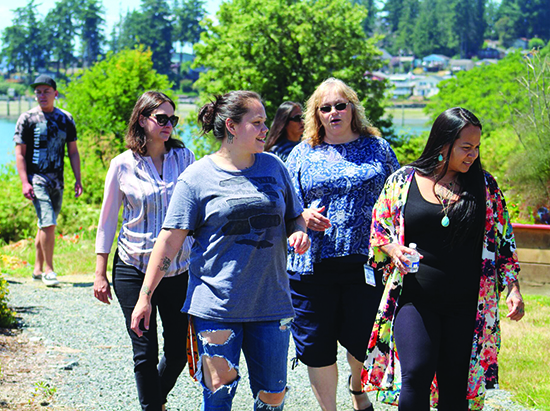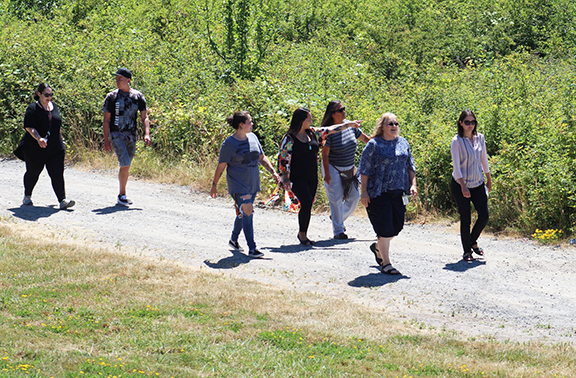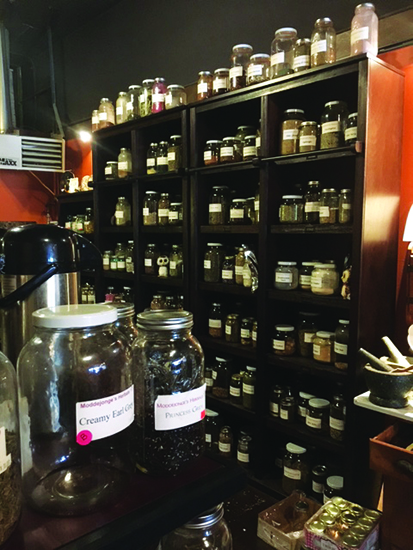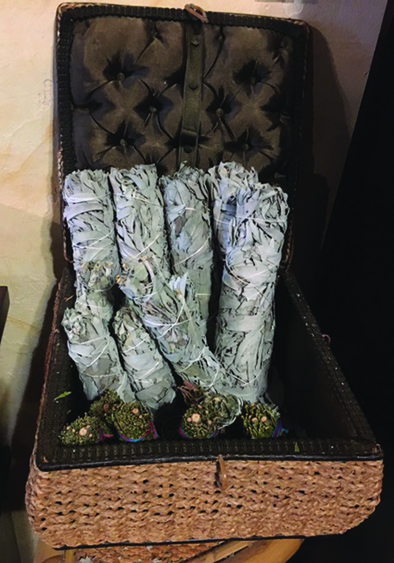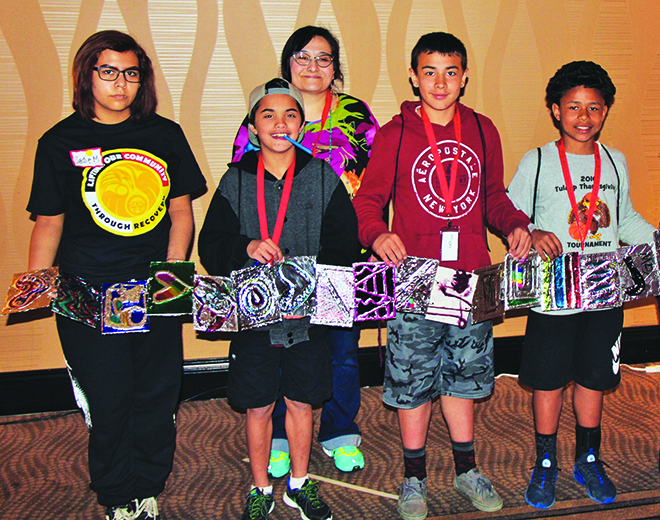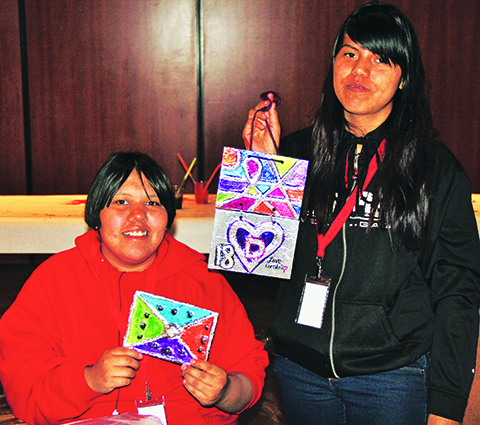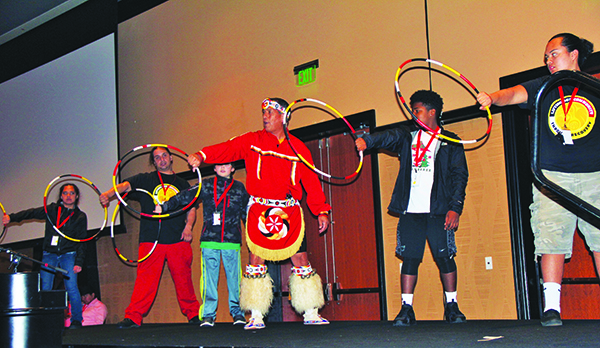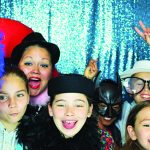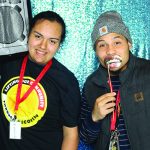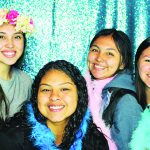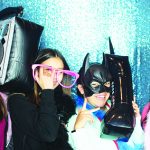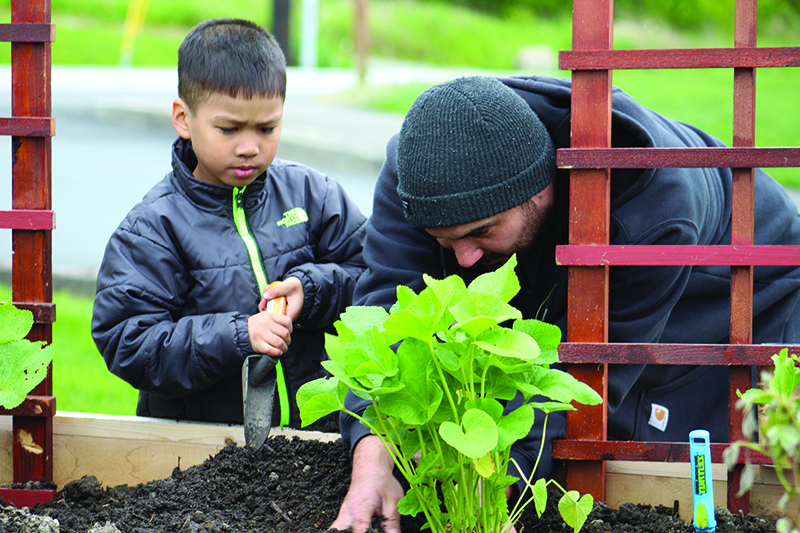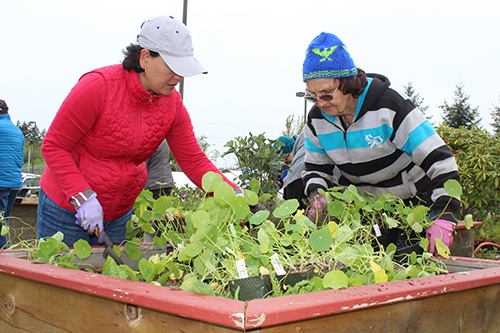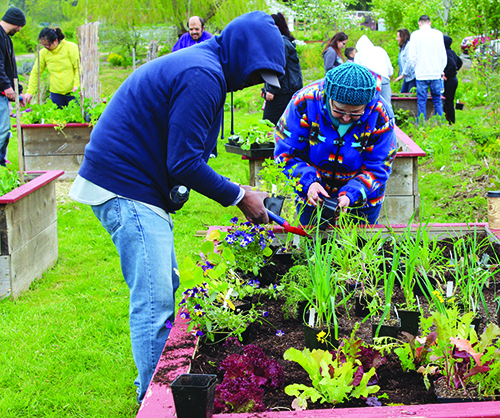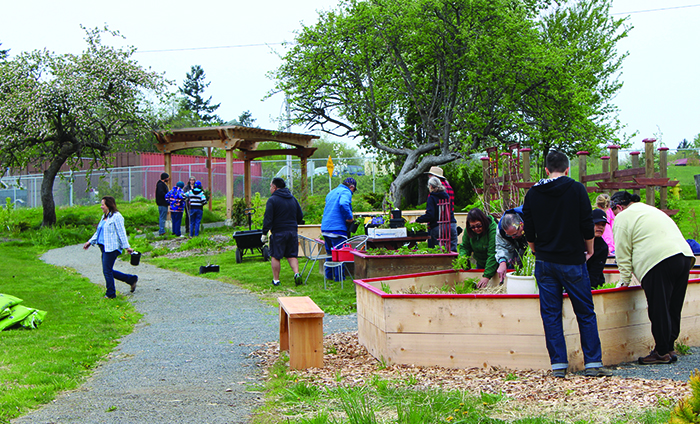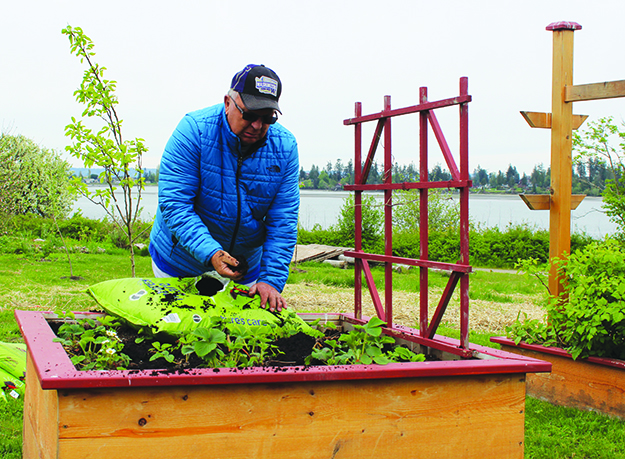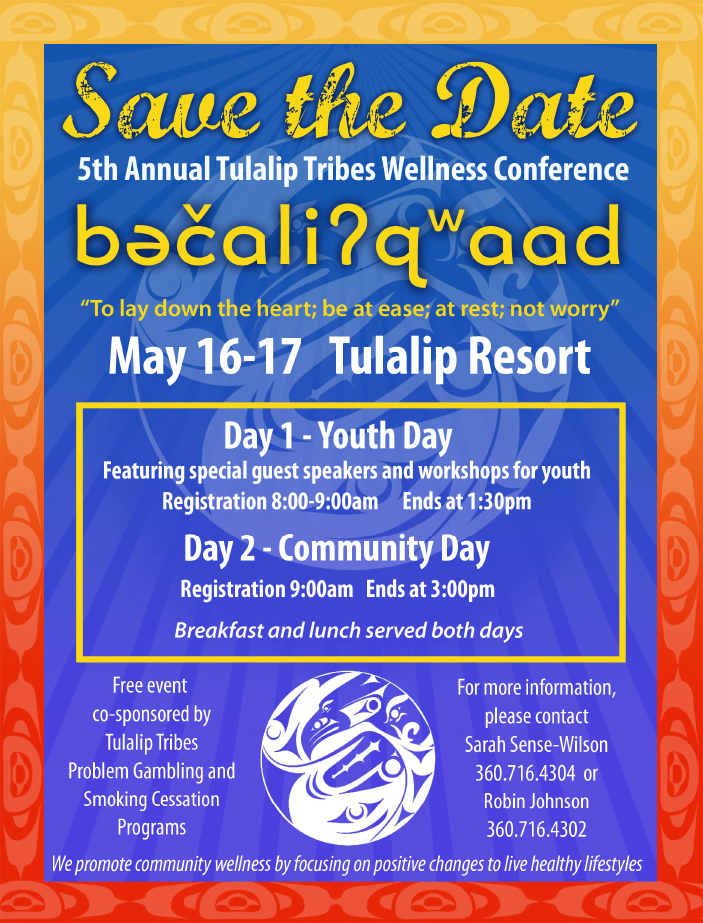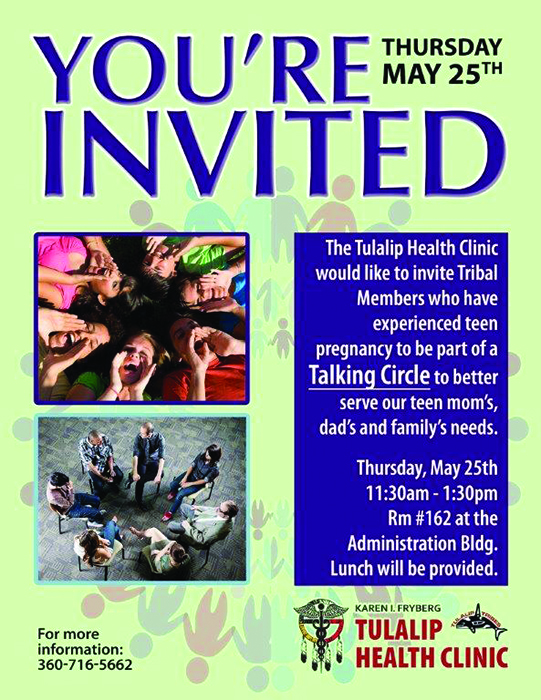Category: Health
Get Your Walk On
By Kalvin Valdillez, Tulalip News
The Tulalip Supplemental Nutrition Assistance Program Education, or SNAP-Ed for short, is making strong efforts to promote healthy lifestyle choices in the Tulalip community. SNAP-Ed teaches about the importance of good nutrition and exercise, alternating between live cooking demonstrations and guided workout regimens each week for Wellness Wednesdays at the Tulalip Administration Building.
Wellness Wednesday is popular amongst Tribal employees as the program has many participants who attend on a regular basis. However, SNAP-Ed is looking to expand their services to Tulalip community members who may not work for the Tribe as well as for those who aren’t able to make it to the Administration Building on Wednesdays. In an effort to reach more community members, SNAP-Ed recently created the Tulalip Tribes Walking Club and held the first community walk on July 11.
“We are implementing the Waking Club to start at a low impact level to get tribal members and community members to be more fit, get outside and be more involved in physical activities,” explains SNAP-Ed Assistant, Traci Fox. “We want to start a community within the community, for physical fitness, so that people feel like they have support and have other people they can talk to about their journey through physical fitness.”
The Walking Club will host one to two sessions per week and the locations will vary between the Karen I. Fryberg Health Clinic and Tulalip Administration Building as well as other areas throughout the community. Walking Club members are awarded with incentives for their efforts and also have the chance to win prizes at the end of each fifteen to thirty minute walking sessions.
“We’re trying to reach a larger demographic and make sure that all tribal people and everyone in the tribal community can be involved in physical activity and can learn to eat better to have a healthy lifestyle,” Traci states.
For further details about joining the Tulalip Walking Club please contact the SNAP-Ed program at (360) 716-4899.
Local Apothecary Focuses on Traditional Healing
By Kim Kalliber, Tulalip News
“We were created out of the earth. Well, we’re part of the earth, and that’s what we’ve got to go back to, the earth, to get something to keep this body a-ticking. Just like the tree, of course, and the herbs here, they’ve got sap in em, and we’ve got blood.”
–Tommie Bass (Appalachian Folk Herbalist)
With the current upsurge of gardening, homesteading and eating traditional and homegrown foods, visiting places like Moddejonge’s Herbals and Other Magical Things, with their extensive knowledge for treating ailments the natural way, is a must-do experience. The aromatic blend of spices, oils, and incense, surrounded by the many jars containing teas and powders along one wall, give the place an overall feel that sets you at ease upon entry.
Located on Hewitt Avenue in downtown Everett, owner Lynn Moddejonge and her knowledgeable staff are there to greet you and offer information, recommendations, remedies and even samples of the day’s tea blend.
“We’ve got over 350 herbs here that are mostly medicinal. We also have magical and cooking herbs, though all the herbs kind of travel between all three genres,” said Lynn. “We’ve got a lot of medicine that is local, like yarrow and St. John’s wort.”
While having heard of the popular St. John’s wort, many folks may not be as familiar with yarrow. Found in the wild throughout the northern hemisphere, yarrow is a member of the sunflower family. Many people use yarrow in teas and tinctures to shorten the duration of colds and flus, as well as relieving cramps, and rashes. Yarrow and mint tea can help ease allergy symptoms.
“I am a folk herbalist. I am not a doctor, I do not diagnose,” explained Lynn. Herbalism is the study of botany and uses plants and foods for healing and for building and maintaining good health.
“We’re a compounding apothecary. All of our herbs are organic or wild-crafted,” said Lynn. “If someone comes in and says, this is the trouble I’m having, we will put something together for you on an individual basis.” She went on to explain that if people keep coming in with the same problem or symptoms, she then mixes larger batches of the medicine to have on hand.
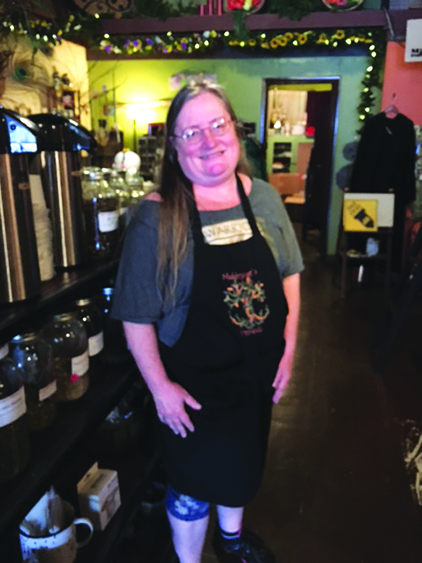
Other highlights of Moddejonge’s are not only the evening workshops they offer, but also the socializing and collaboration between the staff and patrons. It’s a place to swap recipes and discuss tea blends, infusions and tinctures with other folks. “After coming in a couple times, a lot of our customers feel part ownership. And they are very willing to share and hold conversations about their outcomes.”
You can even bring your own ingredients in to be made into a tea or tincture or purchase only the necessary items to use at home. All bulk items are sold by the ounce and shoppers are encouraged bring their own bottles in, as Moddejonge’s is working towards a zero environmental footprint.
I inquired about bringing my own bee honey into the shop to get something made up and Lynn encouraged me to do so, noting the health benefits of honey. “It is a very good way to take medicine. If you infuse honey with something like elderberry, an immune builder, it builds on the immune building properties of the honey. And I can help you with that.”
Among the large selection of in-house crafted essential oils, soaps and other bath and body products, you can even find calming mists and flea medications for your pets, along with mosquito repellants and other summertime essentials.
Lynn makes all the ritual items in the shop herself, as she explains, “That way I know the intent is what it’s supposed to be, as opposed to buying items online. And the herbs we have for ritual include cedar, white sage and sweet grass.”
If you are looking to conduct a house cleansing, she says, “Right off the top, everybody should smudge when they move in because of the previous owner’s energy, and that kind of moves it all out. People smudge differently so we can talk about that and if they’ve never done it before I sit down and say, this is how I do it. We share; there is a lot of sharing here.”
Many folks turn to psychics for an analysis of overall health or lifestyle related questions or situations. Lynn can also help with finding a medium, to aid with grieving, relationship connections, healing and communicating with angels.
“This is an old area and there are a lot of spirits here. If you’ve got spirits visiting you, we can help with that. We offer energy work and readings here and we have contacts with mediums if you are in need. We offer health screenings. There’s a lot of medicine here; spiritual medicine as well as physical medicine.”
While cold and allergy relief are big sellers at Moddejonges, Lynn points out, “Our top product is information. And that’s for free.”
Moddejonge’s Herbals is located at 1905 Hewitt Ave, Everett, WA 98201. You can also follow them on Facebook at https://www.facebook.com/magickandmore/
Septic System Safety
Promoting overall wellness for our youth
Article by Micheal Rios; photos by Micheal Rios and courtesy of Sarah Sense-Wilson
Promoting the physical, mental, emotional, and spiritual health of today’s youth, especially teenagers, is largely a labor of love. It’s difficult enough getting them to give their social media accounts a break, put their cellphones away, and actually focus on educational activities, let alone holding their attention long enough to get them to interact in a group setting. Yet, it is in the commitment to our youth, to their well-being and personal growth that brings about positive changes in lifestyle, relationships, and overall wellness.
Enter the Tulalip Tribes 5th Annual Wellness Conference and its dedicated day, May 16, to promoting overall wellness to our community’s youth.
“Our youth flourish when provided guidance, tools, resources, and encouragement. They thrive when we set good examples of self-care, and live by example. Our individual and collective actions are always far more meaningful and impactful when we are embracing challenges, and having an open mind for learning and taking the time to nurture healthy relationships,” eloquently states Sarah Sense-Wilson, Wellness Conference Coordinator. “I believe our conference really embodies these values and the presenters and workshop leaders exemplify traditional and cultural values we want our children and youth to follow.”
Approximately 90 students from Heritage High School, Marysville-Pilchuck High School, Totem Middle School, and Marysville Middle School were shuttled to the event hosted within the Tulalip Resort Casino’s Orca ballroom. The adolescent youth were treated to a large and healthy buffet-style breakfast after filling out their registration cards and putting on a name tag. As they settled in keynote speaker Layha Spoonhunter (Eastern Shoshone, Northern Arapaho, Oglala Lakota) took center stage.
Layha is a youth consultant, motivational speaker, Two Spirit Native citizen, and vocal advocate for Two Spirit people. He provided honest, open and engaging discussion on LGBTQI (a common abbreviation for lesbian, gay, bisexual, transgender, queer and intersexed community), Two Spirit, and Allyship advocacy.
Layha describes Two Spirit as a “person who has both masculine and feminine identities.” He says it is a spiritual term that encompasses Native culture, language and history. His expertise and experience as a youth spokesperson and advocate for Native youth empowerment bridges differences and strengthens relationships among groups of community members. Layha offered his story as an example for other young LGBTQI and Two Spirit individuals to express themselves and embrace their identities.
“Build an environment of fairness and openness within your community. Stand up against stereotypes and racism. Stand up against bigotry and discrimination,” resounded Layha to his largely youth audience. “Take pride in your identity and use it to make positive change.”
Following the keynote address, the youth were given the choice of three interactive and experiential based workshops to attend. The three diverse workshop presenters were specifically chosen for their ability to reach our Native youth in a variety of ways.
Credentialed Native American mental health specialist and award-winning artist LisaNa Red Bear offered her workshop attendees the opportunity to create a mural art project. Participants engaged in three experiential learning art exercises that support a better understanding of complications associated with smoking. The hands-on creative art project was a hit, as the Native youth’s artistic abilities shined.
“We see an amazing level of creativity expressed by youth who engage in artistic activities. When they allow themselves to imagine and sit still long enough to allow that creativity to flow through them, the results can be awe-inspiring,” reflects LisaNa on the impact of her art mural workshop. “Young people have creativity inside them, innately, and it just depends on whether or not it’s nurtured or repressed.”
Grammy award-winning artist Star Nayea led a Project R.I.S.E Up workshop. She empowered the youth to create video vision statements that involved creating handheld signage decorated with personalized cultural artwork. Participants then took turns filming their own P.S.A. style videos. Star’s unique ability to reach youth and engage them in expressing their ideas, thoughts and feelings led to some amazing video production both individually and collectively. The youth offered messages of hope, vision and inspiration for believing in yourself and living a drug free life.
“Kids just want to know that we, as adults and teachers, are legit. They want to know that we are there for all the right reasons, that we care about them, and that they can thrive from the knowledge and experience we offer,” says Star. “It’s so important for their voices to be heard and for their faces to be seen as they speak the words. It’s one thing to have thoughts and a whole other thing to rise up and share those thoughts, to inspire. In making the P.S.A. videos they help to inspire one another and their community.”
The third workshop option was called In the Spirit of the Story. The tradition of storytelling is a way of passing down, teaching vital lessons, and of course entertainment with a purpose. Gene Tagaban (Tlingit) is an incredibly skillful, knowledgeable and talented storyteller who led this workshop. Using story as a medium for empowerment and self-expression, Gene connected with participants in a deep and meaningful way which transcends all generational differences. The power of storytelling was illuminated through his interactive workshop as a tool for teaching, healing and growing.
“Offering our youth a range of different interactive workshops was intentional and purposeful. We are always wanting to reach our youth for supporting their interests and appeal to their generational issues,” explains Sarah on the importance of workshop variety when working with youth. “Community wellness requires positive action, not passive existence. Some have to work harder because we are up against more barriers, walls, and obstacles. Nonetheless, we have a responsibility to ourselves, our youth, and our community to strive to do better and be better.”
Concluding the youth wellness day was a very special Native Hoop Dance
performance by Tulalip tribal member Terry Goedell. Several youth were brave enough to join Terry on stage and receive a tutorial on hoop dancing basics.
There’s a popular saying in Native communities, “be careful in the decisions we make today as they will impact the 7th generation – our grandchildren’s grandchildren, grandchildren.” Respect for this wisdom continues to guide events like the annual Wellness Conference, where a commitment to preparing Native youth for a brighter future is on full display.
Family Voices: Building Support to Achieve Goals
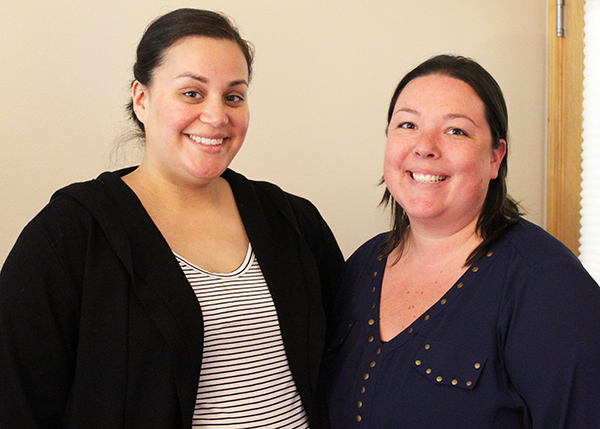
By Kalvin Valdillez, Tulalip News
Family Haven recently introduced a new program to the Tulalip community known as Family Voices. The program implements the WrapAround process while catering to Tulalip youth and families. Initially introduced nationwide in the 1980’s, WrapAround is a four-phase process that helps struggling individuals and families set, define and achieve personal goals by setting up proper support systems, or teams. These teams consist of two types of support, natural support (friends and family) and professional support (counselors and/or therapists), who work together to ensure clients remain steadfast on achieving their goals and also that the entire team is on the same page, much like a multidisciplinary team.
Family Voices is open to all tribal members from the Tulalip community and works primarily with youth facing adversity, around the age of thirteen and older, who are in the system or are frequently truant from school; as well as families who are looking to reconnect, heal and rebuild together.
The program empowers their clients by allowing them to create their own team, comprised of the various trusted members who will assist them throughout the process, such as beda?chelh caseworkers, school counselors, coaches, friends, parents and siblings. By creating a team, the client is held accountable and has the ability to consolidate multiple meetings, which would normally be held on various days throughout each week, into a few meetings per month. The meetings allow the support team an opportunity to find ways each member can assist the client achieve their goals and meet deadlines as well as continue to promote positive vibes and encouragement.
Family Voices facilitators, Sasha Smith and Ashley Tiedeman, explain that the program focuses on the client’s interests and strengths while setting goals. For example, if a client is interested in art or music, the facilitators encourage them to use their creativity as a tool or outlet to reach their ambitions.
“That’s what our position is – to bring everyone together but also make sure the client is getting listened to and that their voice is the one leading the WrapAround process,” said Ashley. “The really cool thing is, especially for clients who are working with multiple programs, they often have people telling them what they need to do. Family Voices is the exact opposite of that. We ask, ‘what does the client want in their life?’ Then we bring in all these people that are saying what they can and cannot do. And often for the first time, they get to listen to the client’s needs, allowing us to meet half way and get things done, but still make sure it’s done with the client’s say-so and make sure it is getting done their way. Because it can be tough having people tell you what to do all the time.”
The program’s length varies as the WrapAround process is client-driven and based on the individual’s goals and needs. Clients typically utilize the program until their personal goal is met. Currently Family Voices has clients on WrapAround plans from nine months up to three years. The team meets on a regular basis, wherever the client is most comfortable such as schools, homes and even Starbucks – initially around twice a week, switching to monthly meetings around six months into the process.
Sasha states, “We are here to guide rather than tell [the client] what to do and make sure they are being heard and supported.”
For additional information about the program please contact the Family Voices Facilitators Sasha Smith (360) 716-4404 or Ashley Tiedeman (360) 716-5719.
Health Clinic program recognized for excellence
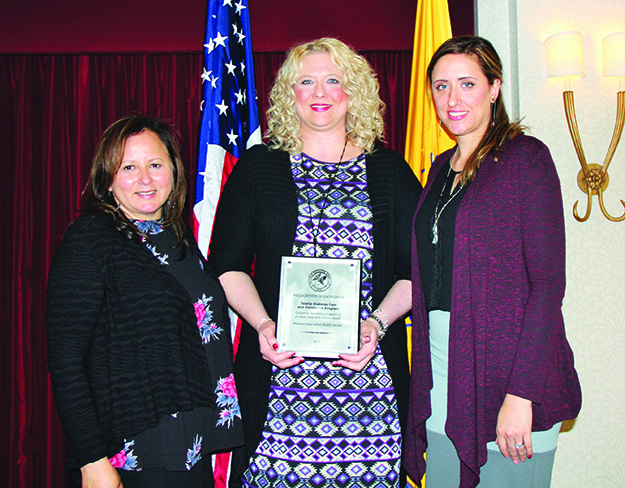
Photo/Tulalip News
By Micheal Rios, Tulalip News
The Indian Health Service (IHS), an agency within the Department of Health and Human Services, is responsible for providing federal health services to 2.2 million Native Americans belonging to 567 federally recognized Tribes. IHS is the principal federal health care provider and health advocate for Native people, and its mission is to raise their physical, mental, social, and spiritual health to the highest possible level.
On the Tulalip Reservation, the Karen I. Fryberg Tulalip Health Clinic is an extension of IHS. The Health Clinic makes it possible to ensure comprehensive, culturally acceptable personal and public health services are available and accessible to tribal members living on or around the reservation.
On Friday, May 12, the IHS Portland Director’s Recognition of Excellence Ceremony was held in downtown Portland, Oregon. Among the very deserving awardees in attendance were familiar faces from the Karen I. Fryberg Health Clinic. They were there to be recognized for excellence and to accept a Portland Area Director’s Award on behalf of the Tulalip Diabetes Care and Prevention Program.
The IHS Portland Area covers all federal and tribal health clinics servicing Native Americans within the states of Washington, Oregon, and Idaho. Among all those health clinics and programs therein, only fifteen groups were recognized and given a Director’s Award.
“Personally, I feel very humbled and honored to receive this award and am grateful to [Director of Clinical Services] Dr. Cooper for taking the time to nominate our team,” said Monica Hauser, RN, CDE, and Certified Diabetes Educator. “I am extremely proud of our diabetes prevention team and am so happy this team has been recognized for everyone’s hard work and dedication to the people of this community.”
“I thought of all of the people who worked in this program before us. I felt their presence in this ceremony and I thank them for their efforts,” added Veronica Leahy, Diabetes Program Coordinator. “My hope is more of our people will come and receive the care and teachings from these truly caring and knowledgeable providers.”
The Tulalip Diabetes Care and Prevention Program is a culturally-grounded, comprehensive program for the treatment of diabetes, and promotion of long-term holistic health. Increasing community participating in health promotion activities has been a staple of the program. Components including individualized case management by certified diabetes educators, continuing education provider-led classes, support groups, Diabetes Day events, and Wellness Trail activities have all achieved the goal of increasing community awareness and engagement in healthy activities.
The Wisdom Warrior program tailored to local community needs has become a major hit. Wisdom Warriors includes a 6-week Stanford University Chronic Disease Self-Management Plan as well as monthly Provider Classes on holistic health related and medical topics. Activities include field trips to the mountains for low-impact day hikes, Medicine Wheel garden classes, support of six tribal department gardens, cooking demonstrations and classes for all ages.
Upcoming Diabetes Prevention Program events include:
- Garden Day – June 3rd (at Youth Services)
- Monthly Wisdom Warrior Provider Class – June 8th
- Diabetes Day – June 15th
- Medicine Wheel Garden Day – June 21st
For more information about the Diabetes Care and Prevention Program please contact Monica Hauser, (360) 716-5725, mhauser@tulaliptribes-nsn.gov or Veronica Leahy, (360) 716-5642, vleahy@tulaliptribes-nsn.gov
AgriCULTURE: Growing produce to promote healthy eating habits
By Kalvin Valdillez, Tulalip News
At an amazing vantage point overlooking Tulalip Bay, community members met behind the Karen I Fryberg Health Clinic, on April 29, to attend the first Tulalip Bay Garden and Trail Class of the year. The class is hosted by the Tulalip Diabetes Care and Prevention Program and unites community members, youth to elders, to educate as well as promote both healthy eating and living habits by planting a variety of fruits, vegetables and flowers.
For centuries, Native American ancestors practiced sustainable agriculture as they incorporated the crops into their everyday diet. Due to events such as the Indian Removal Act and Assimilation, many tribal nations lost the tradition of passing down ancestral knowledge, regarding the growth and harvest of produce. This resulted in poor diets in many Native communities as they transitioned to the modern western diet of high saturated fats and empty carbohydrates. This diet often leads to diabetes, a disease that unfortunately continues to spread throughout Native America as studies show Indigenous People are twice as likely to be diagnosed with the disease, as opposed to other cultures.
Since 2014, the Wellness Garden and Trail has been the outdoor homeroom to participants, many of whom faithfully attend the once-a-month classes between April and September. During each class, participants are presented with an opportunity to learn how to grow produce and are treated to a spectacular view of the bay while walking along the trail that connects the garden and the clinic. Dietician Susan Adams spoke to the community about the importance of proper nutrition and this year participants planted apple trees, carrots, onions, lettuce, broccoli, cauliflower, kale, herbs and an assortment of over 14 berries including blueberries and goji berries.
Garden class participants are encouraged to start the day with a good stretch, by means of yoga, in the newly constructed Medicine Wheel Garden. Tulalip community member and Native American Yoga Instructor, Lisa Foster, provides information about the medicine wheel as she guides participants through each pose, making sure to face all four directions through each sequence.
Attendees were treated to a gift box full of fruits and vegetables donated by Klesick Family Farm as well as lunch, prepared during a live cooking demonstration by community member Brit Reed who is currently attending the Seattle Culinary Academy. During the upcoming months of June and July, Brit will offer cooking classes on Mondays at the Kenny Moses Building for the Diabetes Care and Prevention Program.
Dale Jones, Elder Advocate for the diabetes program states, “[The Tulalip Bay Garden and Trail Class] is here to help people eat right, make the right choices for their health and open their eyes to other choices than McDonalds. Teat-mus used to say ‘it’s pretty funny we have a clown that’s killing our people.’ With all the bad choices we make eating, we’re all guilty. But, we can teach our kids to live better lives than us.”
Tulalip tribal member Jose Diaz, who is only ten years of age, offered to perform the opening prayers as well as the meal blessings for each class held in 2017. Upcoming classes will be held on June 16, July 15, August 26 and September 30.
The diabetes program intends to begin weekday classes in the near future, geared towards adults, where attendees will be working exclusively in the Medicine Wheel Garden. The diabetes program also recently purchased the plants for many programs in Tulalip including the Betty J Taylor Early Learning Academy, the Boys and Girls Club, Youth Services as well as the Senior Center as they recently began growing plants and vegetables in their own gardens.
For additional information regarding Tulalip Bay Garden and Trail Classes and the Tulalip Diabetes Care and Program, please contact the Karen I Fryberg Health Clinic at (360) 716-4511.
Come one, come all to this year’s Wellness Conference
By Micheal Rios, Tulalip News
The 5th Annual Tulalip Tribes Wellness Conference will be taking place at the Tulalip Resort Casino conference rooms on May 16 and 17. The entire community is welcome to attend this free event sponsored by the Problem Gambling and Smoking Cessation programs. Breakfast and lunch will be served on both days, along with a variety of speakers, activities, and workshops that focus on positive changes to live a healthy lifestyle.
“The Wellness Conference is such a good opportunity for our people to come together, visit, and enjoy each other’s company while learning new ways to live healthy,” says Frieda Williams, Tulalip elder and Community Relations Coordinator. “There will be so many good speakers and health experts there to answer any questions you might have about health related services the Tribes offers. Many services you may not be aware of so here’s the chance to learn about them.”
The conference’s second day, May 17, has been dubbed ‘community day’.
“Our Wellness Conference has confirmed a bevy of nationally acclaimed artists, leaders, performers and activists for our community day event,” stated Sarah Sense-Wilson, conference coordinator. “In addition, we will be offering ‘Essential Self-Care’ activities on day two of the conference with over 14 health enhancing, fun, rejuvenating and relaxing workshop stations.”
“We’re hoping to get a great response from the community and see many people attend,” adds Frieda. “There will be plenty of entertainers and activities planned, along with cultural workshops by Inez Bill and Virginia Jones from Hibulb and a healing circle by Deborah Parker. I can’t emphasize enough that the whole Tulalip community is welcome to come, registration is free the day of, so please come and enjoy our Wellness Conference.”
For Tulalip Tribes employees, the GM has approved the conference as a training eligible event. Meaning with supervisor approval you can submit a training and travel request to attend the Wellness Conference during work hours.
